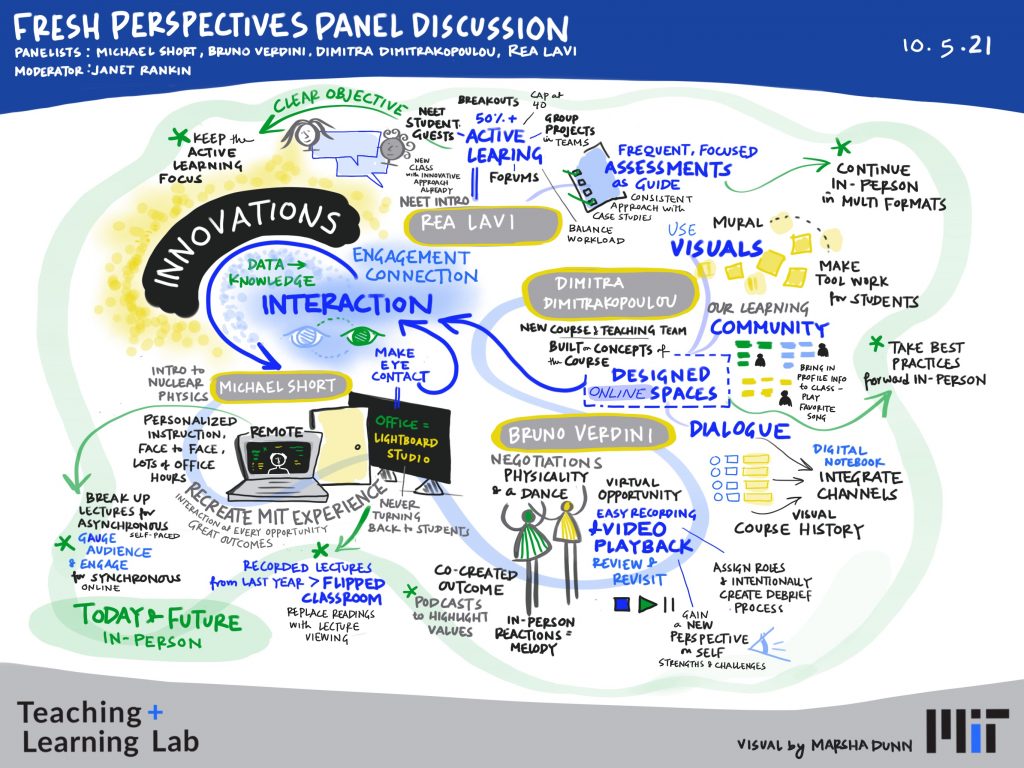Fresh Perspectives from MIT educators (part 2)

On Tuesday, October 5, 2021, the Teaching + Learning Lab hosted the second of two panels featuring faculty and instructors highlighted in the Fresh Perspectives series. Fresh Perspectives is a new ongoing video and audio series launched in 2021 with “Insights from Teaching through a Pandemic,” a set of interviews meant to capture some of the effective teaching techniques adopted during the 2020-2021 school year that could translate well to post-pandemic education.
What strategies did they adopt during the pandemic and what goals did these strategies address?
Professor Short recognized that the value of an MIT education comes not from one-way content delivery, but instead from the opportunity for students to ask questions of their instructors, knowing that the instructors will keep offering explanations until the concepts click. In an attempt to capture this experience in his virtual lectures during the pandemic, he set up a lightboard in his office that allowed him to work through problems while making eye contact with his students. He found that this technique kept students engaged, even more so than in face-to-face contexts where he would have to turn his back to the students to write on the board.
Dr. Verdini describes negotiation as a dance, requiring each negotiator to remain attuned to the emotions and rhythms of the other. Though the narrow view of the Zoom camera limited the information each negotiator could glean from body language, Zoom afforded other opportunities. By recording their negotiations on Zoom, students were able to review the recording, analyzing their own behavior and providing more detailed feedback to their partners. The recordings allowed students to correct misconceptions about how they were perceived and compare their behaviors to how their peers negotiated the same positions.
Dr. Dimitrakopoulou taught a new course alongside Professor Ceasar McDowell and Professor Deb Roy, designing the material from scratch with the virtual setting in mind. Given the course’s focus on communication systems, the instructional team paid particular attention to community and communication within the course. Using Mural, the team created visual digital spaces to share personal information about the students and instructors, convey weekly syllabus information in a clear way, and capture student notes and work throughout the course.
Dr. Lavi also planned his course for the first time remotely. He had the unique challenge of fitting an introduction to the NEET program, several complex “ways of thinking,” and his personal desire to innovate pedagogically within the small footprint of a first-year discovery subject. He tried to spend as much of the class time as possible doing active learning. The course assignments focused on case studies from across the NEET threads, moving from in-class training assignments to scaffold the process to the more complex team assignments that the students completed on their own time. Using Google Forms and similar tools, he built in many small assessments, including both individual and team-based, in-class and out-of-class, and formative and summative to assess recognition, application, and reflection on class concepts. With rich data on student learning, Dr. Lavi kept track of what students understood and gave them individualized feedback as appropriate.
How have they adapted those strategies for the 2021-2022 academic year?
All four panelists described the thoughtful ways they hoped to blend in-person and digital content during the current academic year, reusing many of the materials they created for the virtual versions of their courses. For example, Professor Short is reusing his pre-recorded lightboard videos to replace the textbook, saving class time for questions.
Dr. Verdini described how he had assigned podcasts in addition to reading materials during the pandemic to give students a break from the eye strain associated with looking at a screen and encourage them to go outside while listening. He has continued to assign podcasts this term, noting that the material seems to resonate with students and the format provides a respite from problem sets.
All of the panelists recognized the importance of interaction, both between peers and between students and their instructors, to the creation of knowledge. As they continue to iterate to find the ideal mix of in-person and virtual teaching strategies, fostering two-way communication with their students remains a central goal.
Panelists
- Associate Professor Michael Short, 22.01 Introduction to Nuclear Engineering and Ionizing Radiation
- Lecturer Bruno Verdini, 11.011 The Art and Science of Negotiation & 11.111/17.381 Leadership in Negotiation
- Visiting Scholar Dimitra Dimitrakopoulou, MAS.S69 Constructive Communication Systems: Facilitated Dialogue, Technology, and Design
- Lecturer and Curriculum Designer (NEET program) Rea Lavi, SP.248 Discover the Magic of the Ways of Thinking
Written by Kate Weishaar

